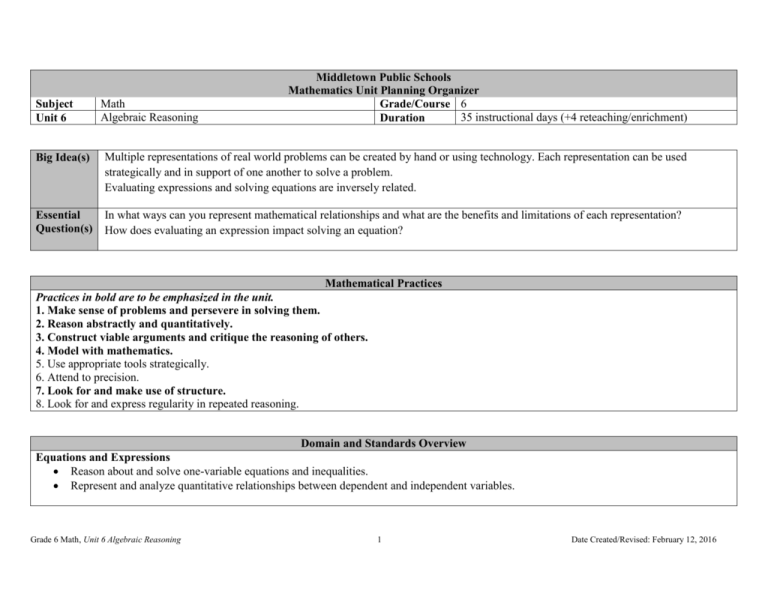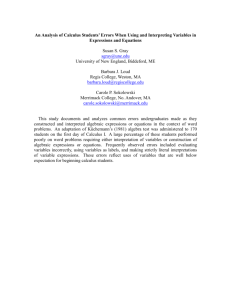Unit 6 Algebraic Reasoning - Middletown Public Schools
advertisement

Subject Unit 6 Math Algebraic Reasoning Middletown Public Schools Mathematics Unit Planning Organizer Grade/Course 6 35 instructional days (+4 reteaching/enrichment) Duration Big Idea(s) Multiple representations of real world problems can be created by hand or using technology. Each representation can be used strategically and in support of one another to solve a problem. Evaluating expressions and solving equations are inversely related. Essential Question(s) In what ways can you represent mathematical relationships and what are the benefits and limitations of each representation? How does evaluating an expression impact solving an equation? Mathematical Practices Practices in bold are to be emphasized in the unit. 1. Make sense of problems and persevere in solving them. 2. Reason abstractly and quantitatively. 3. Construct viable arguments and critique the reasoning of others. 4. Model with mathematics. 5. Use appropriate tools strategically. 6. Attend to precision. 7. Look for and make use of structure. 8. Look for and express regularity in repeated reasoning. Domain and Standards Overview Equations and Expressions Reason about and solve one-variable equations and inequalities. Represent and analyze quantitative relationships between dependent and independent variables. Grade 6 Math, Unit 6 Algebraic Reasoning 1 Date Created/Revised: February 12, 2016 Priority and Supporting Common Core State Standards Bold Standards are Priority 6.EE.9. Use variables to represent two quantities in a real-world problem that change in relationship to one another; write an equation to express one quantity, thought of as the dependent variable, in terms of the other quantity, thought of as the independent variable. Analyze the relationship between the dependent and independent variables using graphs and tables, and relate these to the equation. For example, in a problem involving motion at constant speed, list and graph ordered pairs of distances and times, and write the equation d = 65t to represent the relationship between distance and time. Explanations and Examples 6.EE.9. Students can use many forms to represent relationships between quantities. Multiple representations include describing the relationship using language, a table, an equation, or a graph. Translating between multiple representations helps students understand that each form represents the same relationship and provides a different perspective on the function. Examples: • What is the relationship between the two variables? Write an expression that illustrates the relationship. • Use the graph below to describe the change in y as x increases by 1. • Susan started with $1 in her savings. She plans to add $4 per week to her savings. Use an equation, table and graph to demonstrate the relationship between the number of weeks that pass and the amount in her savings account. o Language: Susan has $1 in her savings account. She is going to save $4 each week. o Equation: y = 4x + 1 o Table: Grade 6 Math, Unit 6 Algebraic Reasoning 2 Date Created/Revised: February 12, 2016 o Graph: 6.EE.6. Use variables to represent numbers and write expressions when solving a real-world or mathematical problem; understand that a variable can represent an unknown number, or, depending on the purpose at hand, any number in a specified set. 6.EE.6. Connecting writing expressions with story problems and/or drawing pictures will give students a context for this work. It is important for students to read algebraic expressions in a manner that reinforces that the variable represents a number. Examples: • Maria has three more than twice as many crayons as Elizabeth. Write an algebraic expression to represent the number of crayons that Maria has. (Solution: 2c + 3 where c represents the number of crayons that Elizabeth has.) • An amusement park charges $28 to enter and $0.35 per ticket. Write an algebraic expression to represent the total amount spent. (Solution: 28 + 0.35t where t represents the number of tickets purchased) • Andrew has a summer job doing yard work. He is paid $15 per hour and a $20 bonus when he completes the yard. He was paid $85 for completing one yard. Write an equation to represent the amount of money he earned. (Solution: 15h + 20 = 85 where h is the number of hours worked) • Describe a problem situation that can be solved using the equation 2c + 3 = 15; where c represents the cost of an item. • Bill earned $5.00 mowing the lawn on Saturday. He earned more money on Sunday. Write an expression that shows the amount of money Bill has earned. (Solution: $5.00 + n) • The commutative property can be represented by a + b = b + a where a and b can be any rational number. 6.EE.7. Solve real-world and mathematical problems by writing and solving equations of the form x + p = q and px = q for cases in which p, q and x are all nonnegative rational numbers. Grade 6 Math, Unit 6 Algebraic Reasoning 3 Date Created/Revised: February 12, 2016 6.EE.7. Students create and solve equations that are based on real world situations. It may be beneficial for students to draw pictures that illustrate the equation in problem situations. Solving equations using reasoning and prior knowledge should be required of students to allow them to develop effective strategies. Example: • Meagan spent $56.58 on three pairs of jeans. If each pair of jeans costs the same amount, write an algebraic equation that represents this situation and solve to determine how much one pair of jeans cost. Sample Solution: Students might say: “I created the bar model to show the cost of the three pairs of jeans. Each bar labeled J is the same size because each pair of jeans costs the same amount of money. The bar model represents the equation 3J = $56.58. To solve the problem, I need to divide the total cost of 56.58 between the three pairs of jeans. I know that it will be more than $10 each because 10 x 3 is only 30 but less than $20 each because 20 x 3 is 60. If I start with $15 each, I am up to $45. I have $11.58 left. I then give each pair of jeans $3. That’s $9 more dollars. I only have $2.58 left. I continue until all the money is divided. I ended up giving each pair of jeans another $0.86. Each pair of jeans costs $18.86 (15+3+0.86). I double check that the jeans cost $18.86 each because $18.86 x 3 is $56.58.” (continued on next page) • Julio gets paid $20 for babysitting. He spends $1.99 on a package of trading cards and $6.50 on lunch. Write and solve an equation to show Grade 6 Math, Unit 6 Algebraic Reasoning 4 Date Created/Revised: February 12, 2016 how much money Julio has left. (Solution: 20 = 1.99 + 6.50 + x, x = $11.51) Concepts What Students Need to Know Variable Two quantities that change in relationship to one another o Dependent variable o Independent variable Expression Equation Graph Table Skills What Students Need to Be Able to Do USE (variables) REPRESENT (dependent and independent variables) WRITE (expressions and equations) ANALYZE (relationships) USE (graphs and tables) RELATE (to the equation) REPRESENT (numbers) SOLVE (problems by writing and solving equations of the form x + p = q and px = q (p,q and x 0) Bloom’s Taxonomy Levels Depth of Knowledge Levels 3 2 3 4 3 4,5 2 3 Learning Progressions The standards below represent prior knowledge and enrichment opportunities for standards in this unit. Standard Prerequisite Skills Accelerate Learning 6.EE.7. Solve real-world and mathematical Solve real life and mathematical problems using problems by writing and solving equations numerical and algebraic expressions and Write and interpret numerical expressions. of the form x + p = q and px = q for cases in equations. 7.EE.3-4 5.OA.1-2 which p, q and x are all nonnegative rational numbers. 6.EE.9. Use variables to represent two quantities in a real-world problem that Grade 6 Math, Unit 6 Algebraic Reasoning Analyze patterns and relationships. 5.OA.3 5 Create equations that describe numbers or relationships. Linear, quadratic, exponential. Date Created/Revised: February 12, 2016 A.CED.1-4 change in relationship to one another; write an equation to express one quantity, thought of as the dependent variable, in terms of the other quantity, thought of as the independent variable. Analyze the relationship between the dependent and independent variables using graphs and tables, and relate these to the equation. Unit Assessments Performance Task Common Formative Assessment Grade 6 Math, Unit 6 Algebraic Reasoning 6.EE.9 6 Date Created/Revised: February 12, 2016




